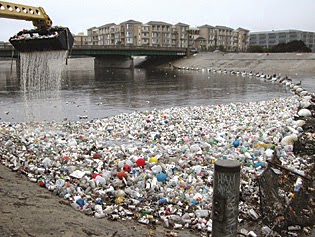Activists 'Shut Down' Nestlé Water Bottling Plant in Sacramento
This one's on everyone who thinks water comes in a little plastic bottle. When are we going to brain up!
Nestlé is currently the leading supplier of the world’s bottled water, including such brands as Perrier and San Pellegrino. It has 7,500 employees and 29 bottled water facilities across the U.S. and Canada, and annual revenues were $4.0 billion in 2012, up 6.8% from 2011.
For nearly four decades, activists from an array of organizations have criticized the company for its human rights violations throughout the world.
Environmental and human rights activists, holding plastic “torches” and “pitchforks,” formed human barricades at both entrances to the Nestlé Waters bottling plant in Sacramento March 20, effectively shutting down the company's operations for the day.
Representatives of the alliance said the company is draining up to 80 million gallons of water a year from Sacramento aquifers during a record drought. They claim Sacramento City Hall has made it possible through a "corporate welfare giveaway."
“Nestlé pays only 65 cents for each 470 gallons it pumps out of the ground – the same rate as an average residential water user. But the company can turn the area's water around, and sell it back to Sacramento at mammoth profit,” according to a news release from the activists.
The bottling plant in Sacramento is not the only one in California. A recent investigation in the Desert Sun found that Nestlé Waters North America has been pumping water from pristine streams of the San Bernardino National Forest with little to no oversight by the U.S. Forestry Service. (http://www.desertsun.com/...)
“Nestlé Waters North America holds a longstanding right to use this water from the national forest near San Bernardino,” according to the Sun. “But the U.S. Forest Service hasn't been keeping an eye on whether the taking of water is harming Strawberry Creek and the wildlife that depends on it. In fact, Nestle's permit to transport water across the national forest expired in 1988. It hasn't been reviewed since, and the Forest Service hasn't examined the ecological effects of drawing tens of millions of gallons each year from the springs.”
Read the full story HERE!
Nestlé is currently the leading supplier of the world’s bottled water, including such brands as Perrier and San Pellegrino. It has 7,500 employees and 29 bottled water facilities across the U.S. and Canada, and annual revenues were $4.0 billion in 2012, up 6.8% from 2011.
For nearly four decades, activists from an array of organizations have criticized the company for its human rights violations throughout the world.
 | ||
| Only 20% of all plastic water bottles get recycled. The rest... |
Representatives of the alliance said the company is draining up to 80 million gallons of water a year from Sacramento aquifers during a record drought. They claim Sacramento City Hall has made it possible through a "corporate welfare giveaway."
“Nestlé pays only 65 cents for each 470 gallons it pumps out of the ground – the same rate as an average residential water user. But the company can turn the area's water around, and sell it back to Sacramento at mammoth profit,” according to a news release from the activists.
The bottling plant in Sacramento is not the only one in California. A recent investigation in the Desert Sun found that Nestlé Waters North America has been pumping water from pristine streams of the San Bernardino National Forest with little to no oversight by the U.S. Forestry Service. (http://www.desertsun.com/...)
“Nestlé Waters North America holds a longstanding right to use this water from the national forest near San Bernardino,” according to the Sun. “But the U.S. Forest Service hasn't been keeping an eye on whether the taking of water is harming Strawberry Creek and the wildlife that depends on it. In fact, Nestle's permit to transport water across the national forest expired in 1988. It hasn't been reviewed since, and the Forest Service hasn't examined the ecological effects of drawing tens of millions of gallons each year from the springs.”
Read the full story HERE!



.jpg)

Comments
Post a Comment